Recommending the best thyroid recipes isn’t always easy.
Most people today are wrongly led to believe that a healthy diet is simply a matter of eating healthy foods and avoiding unhealthy ones.
But that’s just not the case.
Take water for example…
Everyone knows that we need water to live, and that water is healthy.
But too much water can also be dangerous and even deadly, resulting from an electrolyte imbalance commonly referred to as water poisoning.
With a truly healthy diet there are many other factors to account for, such as the balance of nutrients… macro-nutrients and micro-nutrients included.
It’s more like chemistry than anything…
It requires the right combinations of ingredients, in the right amounts, combined at the right times, and oftentimes in the right order for the end result to be truly successful.
But that doesn’t mean it has to be complicated.
That’s what we do for our clients.
We remove the head-scratching, misinformation, and confusion so you can just enjoy eating healthy and delicious thyroid recipes and meals without having to even think about it.
So, today we’re sharing seven simple and delicious thyroid recipes, some of which can be used together for an even greater thyroid-boosting effect.
(Note: not all of these thyroid recipes are our recipes, so we have made very minor tweaks where needed to make them Forefront Health approved.)
Let’s jump right in (and start with dessert first because dessert is always our favorite)…
1. Orange Creamsicles
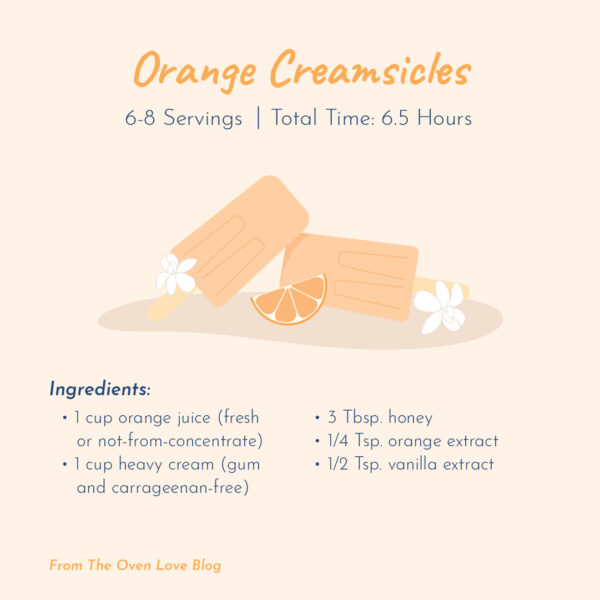
Orange Creamsicles
Source: http://www.ovenloveblog.com/orange-creamsicles/ Ingredients
- 1 cup orange juice (fresh or not-from-concentrate)
- 1 cup heavy cream (gum and carrageenan-free)
- 3 tablespoons honey
- ¼ teaspoon orange extract
- ½ teaspoon vanilla extract
Instructions In a medium bowl, whisk all ingredients together. Pour mixture into popsicle molds. Let set for 30-60 minutes, then add popsicle sticks. Freeze for another 4-6 hours or until frozen. When you’re ready to serve, run some warm water along your popsicle mold to loosen the popsicles and serve immediately.
A few things we like about this recipe…
This recipe is perfect as a refreshing treat in the summer heat.
Elevated temperatures increase your use of blood sugar, and this recipe can used to help keep your blood sugar stable.
The fructose content from the orange juice and honey is very therapeutic, even for diabetics while the cream helps to slow the digestion of the fructose, making it even more beneficial.
“The special value of fructose is that it can be oxidized even by diabetics, lacking insulin, and that it increases the metabolic rate, causing calories to be burned at a higher rate.” – Dr. Raymond Peat
(Note: most commercial creams today use carrageenan or other gums as a thickening agent, so make sure that your cream is free of gums and carrageenan.)
2. Honey Baked Custard
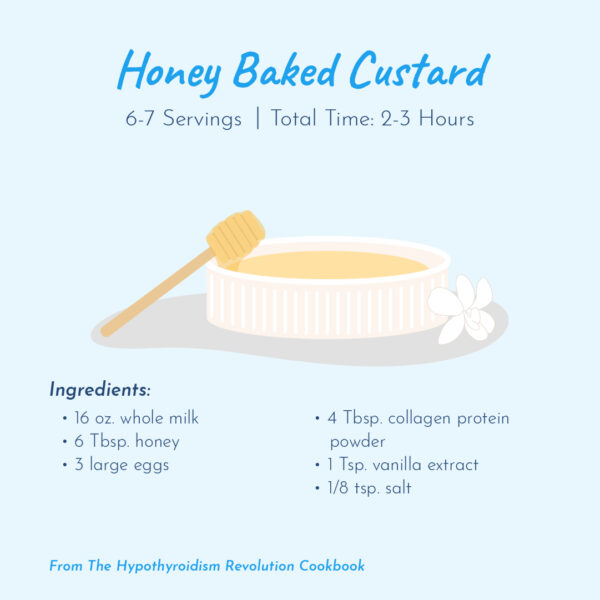
Honey Baked Custard
Source: Hypothyroidism Revolution Cookbook Ingredients
- 16 oz. (480 ml) whole milk
- 6 tbsp. (90 ml) honey
- 3 large eggs
- 4 tbsp. (60 ml) collagen protein powder
- 1 tsp. (5 ml) vanilla extract
- 1/8 tsp. (0.6 ml) salt
Directions Note: If you are using raw milk in this recipe, you must first scald the milk. To do this, slowly heat the milk until bubbles begin to form around the edge of the pot. Be sure to let milk cool before proceeding with the recipe. Bring a pot of water to a boil and preheat your oven to 325°F (163°C). Add all ingredients to a blender and blend thoroughly. Pour the custard mixture into a 1½ quart glass baking dish or 6 to 7 small ramekins. Place the custard dish or ramekins inside a larger glass baking dish. Fill the larger baking dish with the hot boiling water, surrounding the custard dish. Be careful not to get water into the custard or overfill the large baking dish. Place in the oven for and cook for 60 to 90 minutes. When the custard is set, a knife will cut the custard and come out cleanly. Allow to cool and store in refrigerator.
A few things we like about this recipe…
It’s extremely nutrient dense with everything needed to support healthy thyroid function.
This is actually one of our thyroid recipes we use in our Hypothyroidism Revolution Program as a dessert or snack.
And it really does taste amazing.
There are too many benefits to cover, such as the calcium from the dairy to help balance the phosphates in your diet, which helps regulate parathyroid hormone while helping to lower and regulate the inflammation caused by your hypothyroidism.
3. Homemade Ricotta Cheese
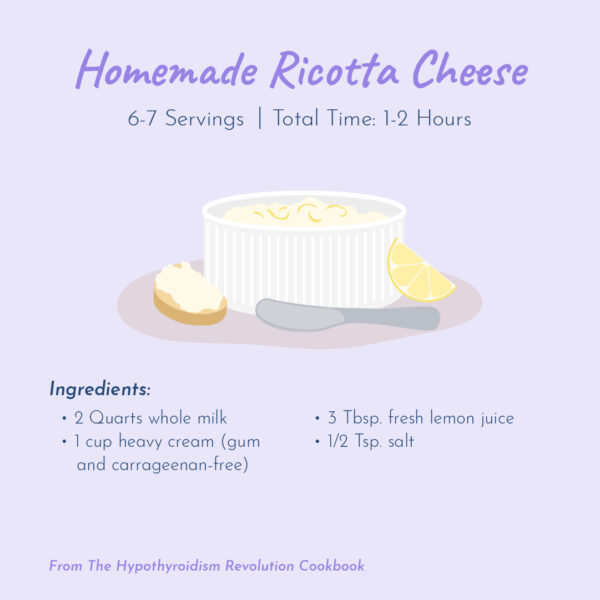
Homemade Ricotta Cheese
Source: Hypothyroidism Revolution Cookbook Ingredients
- 2 Quarts (1.9 L) whole milk
- 1 cup (240 ml) heavy cream (gum and carrageenan-free)
- 3 Tbsp. (45 ml) fresh lemon juice
- ½ tsp. (2.5 ml) salt
Directions Note: You will also need a large strainer and fine mesh cheesecloth. Line the strainer with the cheesecloth and place inside a large bowl. Add the milk, cream, and salt to a large pot and slowly bring to a rolling boil over medium heat, mixing slowly to avoid burning the milk. Add the lemon juice and reduce to low heat and simmer. Stir constantly for at least 2 minutes while the mixture curdles. Pour mixture into the strainer and drain for 1 hour. Discard the liquid, cover the cheese, and refrigerate. Ricotta will keep fresh for 2 weeks.
What we like about this recipe…
Hypothyroidism oftentimes leads to dairy intolerance, which is something we always work to correct with our clients.
(Note: Do you struggle with dairy? If so, then make sure to read through this article on “How to Overcome Dairy Intolerance Once and For All“.)
This is an extremely safe and delicious cheese that can oftentimes be tolerated by even the most sensitive of people.
And again, the calcium is essential for overcoming your hypothyroidism and Hashimoto’s thyroiditis.
This recipe doesn’t use any harmful enzymes, nor contain any of the harmful thickeners used in just about all of the store-bought ricotta cheeses you’ll find on your grocery store shelves.
4. Parmesan Baked Potato Halves
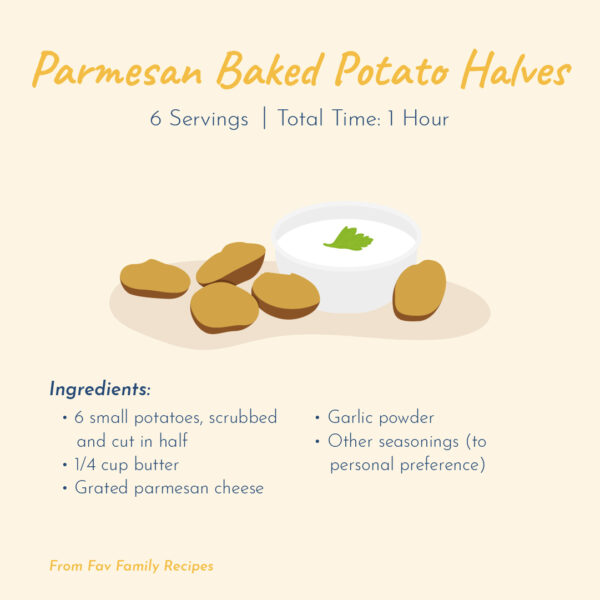
Parmesan Baked Potato Halves
Source: http://www.favfamilyrecipes.com/parmesan-baked-potato-halves.html Ingredients
- 6 small potatoes, scrubbed and cut in half
- 1/4 cup (60 ml) butter
- grated parmesan cheese
- garlic powder
- other seasonings (to personal preference)
Instructions Preheat oven to 400F/ 204C. Melt butter and pour into a 9×13 inch pan and spread evenly across the bottom. Generously sprinkle parmesan cheese and lightly sprinkle other seasonings all over the butter. Place potato halves face down on the butter and seasonings. Place in preheated oven and bake for 40 to 45 minutes. Cool for at least a FULL 5 minutes before removing from the pan, otherwise the parmesan crust won’t stick to the potato. Serve on a plate with a side of sour cream for dipping.
A few things we like about this recipe…
If you’ve tasted these potatoes then you don’t even need to ask.
Parmesan cheese is one of the most nutrient dense food sources there is.
And being traditionally made with real rennet makes it one of the safest cheeses there is… even for those with dairy sensitivities.
(Note: I believe in all my years I’ve only had one client who had to wait before re-introducing Parmesan cheese.)
Potatoes themselves are also a great source of very high quality nutrition.
However, they are starchier so those who are diabetic or insulin resistant may need to be cautious.
Although, when used with the creamsicle it becomes safer and helps provide a better balance.
We do address these very issues of diabetes and insulin resistance with our clients, which you can learn more about in this article on “Hypothyroidism and Diabetes: How to Reverse It and Why Sugar Is NOT the Problem“.
5. Shrimp Saganaki
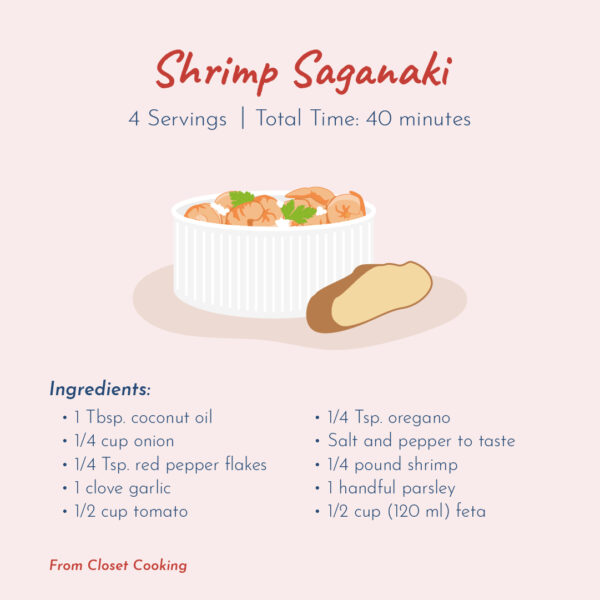
Shrimp Saganaki
Source: http://www.closetcooking.com/2008/10/garides-saganaki-shrimp-saganaki.html Ingredients
- 1 tablespoon (15 ml) coconut oil
- 1/4 cup (60 ml) onion (chopped)
- 1/4 teaspoon (1.25 ml) red pepper flakes
- 1 clove garlic (chopped)
- 1/2 cup (120 ml) tomato (chopped)
- 1/4 teaspoon (1.25 ml) oregano
- salt and pepper to taste
- 1/4 pound (115 g) shrimp
- 1 handful parsley (chopped)
- 1/2 cup (120 ml) feta (crumbled)
Directions Heat the oil in a pan. Add the onion and saute until soft, about 5 minutes. Add the red pepper flakes and garlic and saute for 30 seconds. Add the tomato and oregano and simmer until the sauce thickens, about 5 minutes. Add the shrimp and simmer for 30 seconds per side. Remove from heat and stir in the parsley. Transfer to a baking dish and top with the feta cheese. Bake in a preheated 425F/220C oven until the sauce is bubbly, about 10 minutes.
A few things we like about this recipe…
Shrimp is a great source of selenium that is necessary for the conversion of thyroid hormone in your liver. It’s also a great source of zinc that can help to improve estrogen dominance.
Because of hypothyroidism effects on your glucuronidation pathway, hypothyroidism sufferers quickly develop issues with estrogen dominance that further suppresses thyroid function.
6. Parmesan Eggs
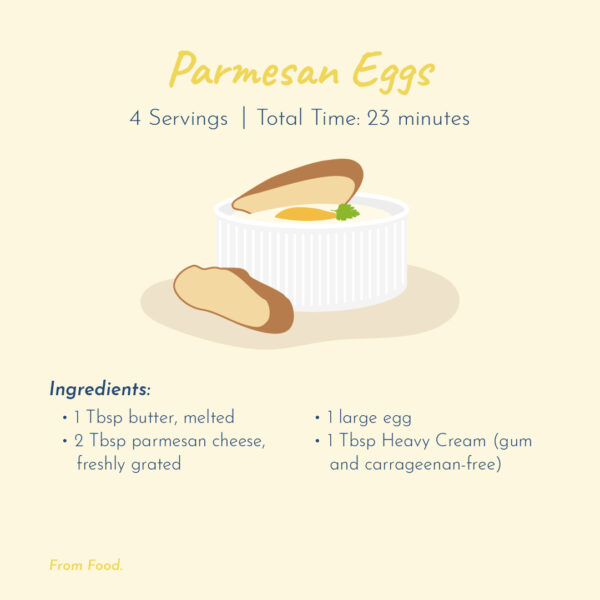
Parmesan Eggs
Source: http://www.food.com/recipe/parmesan-eggs-164457
Ingredients
- 1 Tbsp (15 ml) butter, melted
- 2 Tbsp (30 ml) parmesan cheese, freshly grated
- 1 large egg
- 1 Tbsp (15 ml) Heavy Cream (gum and carrageenan-free)
Directions Preheat oven to 350°F (177°C). Butter an individual ramekin, and then dust with 1 tablespoon (15 ml) of cheese. Break egg into ramekin and cover with cream. Sprinkle with remaining cheese. Bake 10 to 15 minutes, until white is set. Serve hot in ramekin.
What we like about this recipe…
This is an amazing delicious and amazingly simple breakfast recipe that is packed with thyroid-healing nutrition.
Parmesan cheese still requires that it be made using traditional rennet, not the harmful microbial rennet found in most cheeses today.
This means that it’s extremely safe to eat, and most will tolerate it perfectly fine.
And being a dense hard cheese, it’s difficult to find a more nutrient-dense thyroid-healing food anywhere.
Are you seeing the recurring theme of the importance of calcium?
7. (Almost Perfect) Chicken Liver Pate
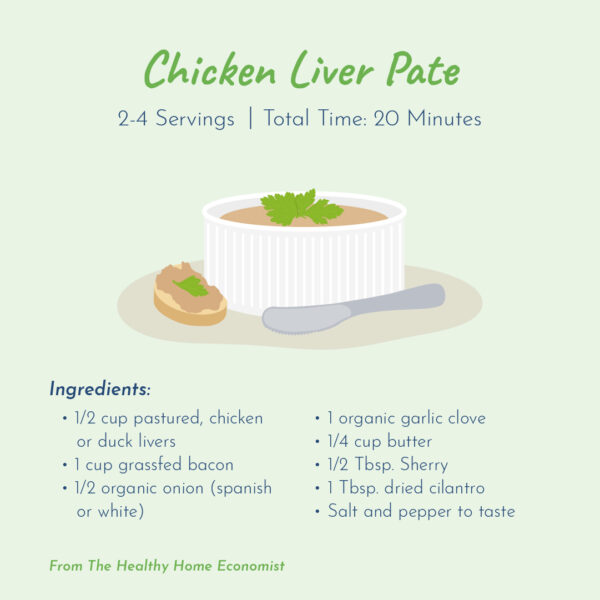
Chicken Liver Pate
Source: http://www.thehealthyhomeeconomist.com/video-chicken-liver-pate/ Ingredients
- 1/2 cup (120 ml) pastured, chicken or duck livers
- 1 (240 ml) cup chopped grassfed bacon
- 1/2 organic onion, chopped (spanish or white)
- 1 organic garlic clove, minced
- 1/4 cup (60 ml) butter
- 1/2 Tbsp. (7.5 ml) Sherry
- 1 Tbsp. (15 ml) dried cilantro
- Salt and pepper to taste
Directions Melt butter in a saucepan and lightly saute chicken livers until just pink in the center. In a separate saucepan, saute the chopped bacon for a few minutes and then add the onion and garlic. Saute until the onion is slightly carmelized and the bacon is cooked through. Transfer the contents of both pans to a glass bowl and mix in sherry and cilantro. Let cool for 10 minutes. Transfer to a food processor and blend until very smooth. Taste. Add sea salt and pepper if needed and pulse the food processor a few times to mix. Transfer chicken liver pate to a small, glass bowl with a lid and chill for 1-2 hours until set.
What we like about this recipe…
Not everyone has an acquired taste for liver. In fact, most are right out afraid of it. But this recipe amazingly masks the strong and oftentimes unpleasant taste of liver.
We call it “almost perfect” for two reasons.
- Soaking the liver in milk prior to use will help further mask the livery taste.
- The bacon should be partially cooked, fat drained, and then cooked to completion in coconut oil in order to help minimize the thyroid-suppressive PUFAs of the bacon fat.
The thyroid-healing benefits of liver are too many to pass up without a fight.
For example, it’s extremely rich in high-quality and usable vitamin A, which is essential for your body to use thyroid hormone properly.
Vitamin A is so important to thyroid health that studies have shown that it can help reduce TSH by up to the 33% while increasing T3 up to 61%.
The effect of vitamin A supplementation on thyroid function in premenopausal women. http://www.ncbi.nlm.nih.gov/pubmed/23378454 “Vitamin A caused a significant reduction in serum TSH concentrations in obese (p = 0.004) and nonobese (p = 0.001) groups. Serum T3 concentrations also increased in both obese and nonobese vitamin A-treated groups (p < 0.001). Serum T4 decreased in all 3 groups after treatment.”
It’s best to have liver with some coffee to help prevent the absorption of too much iron, which in excess is extremely toxic.
But, a few ounces of liver once or twice a week can result in a drastic improvement in your thyroid health.
So, there you have it.
Bon Appétit!
Just make sure you make enough for leftovers.
You can thank me later.
(Forefront Health Members: Don’t forget to access your Ultimate Thyroid-Boosting Meal Plan for even more scientifically designed thyroid recipes. Use these recipes to boost your thyroid health to the next level. Not a member? Click here to learn more.)
New to Forefront Health?
No Problem.
Don’t forget to download our 3 Food Triple-Thyroid-Boosting Daily Protocol, we’ll show you exactly how you can start using your diet to further unblock your Thyroid Hormone Pathway and fix some of the other many underlying causes of your hypothyroidism.
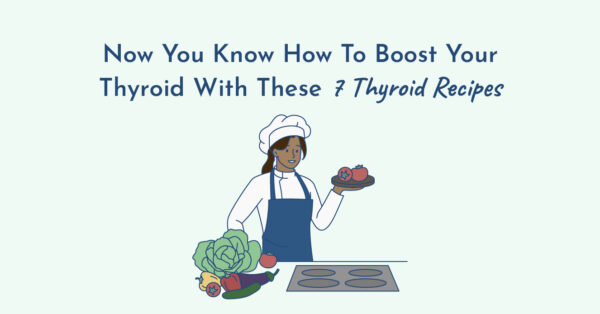
KEY IDEA
Learn seven delicious recipes designed to support thyroid health for people with hypothyroidism. A healthy diet is more complex than simply eating “good” foods, and requires understanding nutrient balance. The recipes include a variety of delicious dishes like Orange Creamsicles, Honey Baked Custard, Homemade Ricotta Cheese, Parmesan Baked Potato Halves, Shrimp Saganaki, Parmesan Eggs, and Chicken Liver Pate. Each recipe is selected not just for taste, but for specific nutritional benefits that can help improve thyroid function.


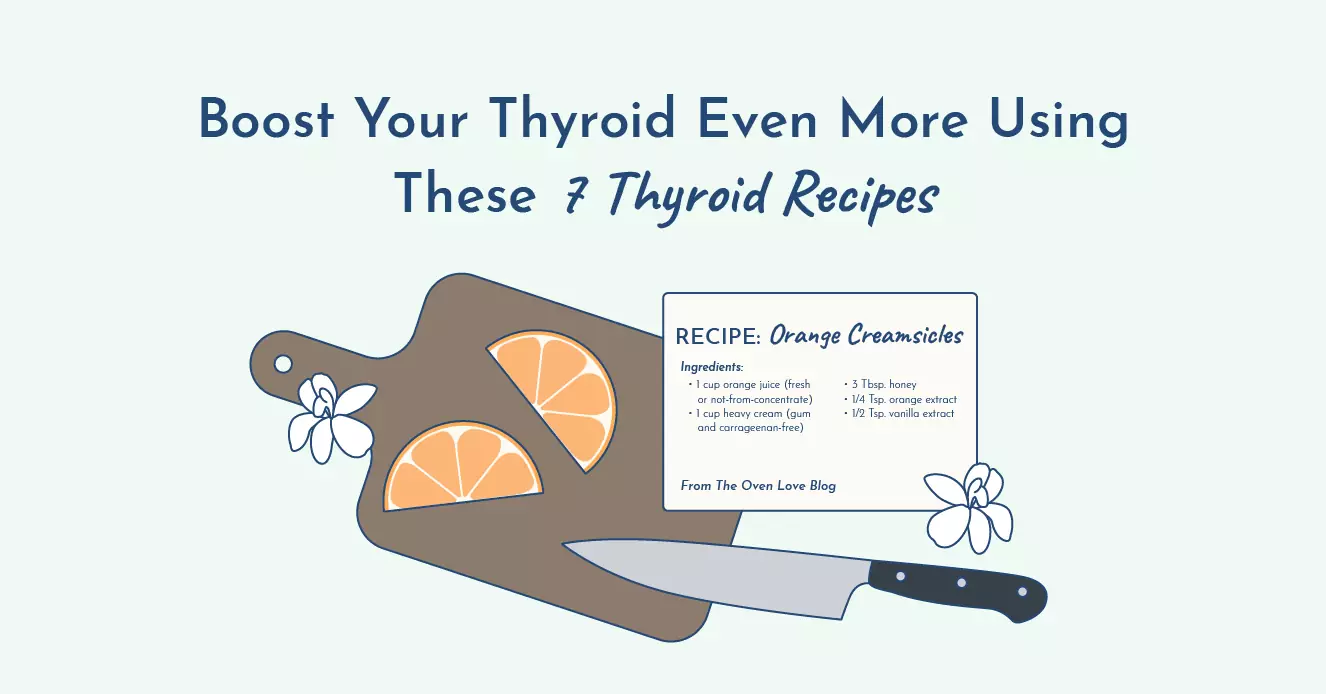


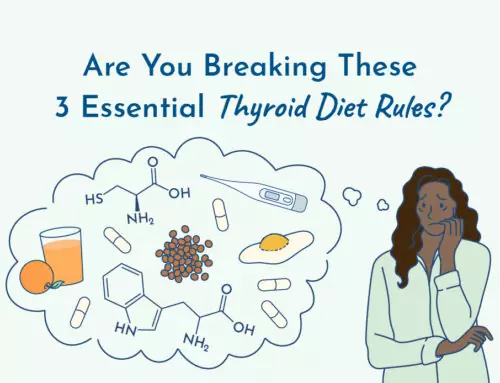

These recipes are unbelievable! I will be trying them for sure. Thank you, Tom! I look forward to more recipes like these. One question. Can we add gelatin to the popsicles to up the protein?
You’re welcome. And yes to the popsicles. That’s what I do.
I do not tolerate nightshade plants well so I prefer sweet potatoes and generally leave white ones out of my diet.
Sweet potatoes can be steamed and mashed with cinnamon and butter added, they can be baked and eaten with the skins, with or without butter, Do you have access to other recipes for sweet potatoes?
Also any gluten free recipes?
Thanks
Catherine
Are all of your recipes gluten free?
Everything we do is gluten-free.
I have a few questions, please.
These recipes look amazing! Can’t wait to try them!
On the shrimp dish, can any other cheese be subbed for the feta? Just can’t get it down. ? Sorry.
These questions are about your three recommended foods for thyroid. Really need help with this. So, I’m so very thankful to find you. ?
I’m very new to this, so please forgive me if I’ve missed the info as I’ve read. There’s so much wonderful info here, it’s a bit overwhelming when new to it all.
Thank you so much for giving of yourself to help others who are suffering. As an RN, I know the joy that can bring.
Thanks again,
Jacqui
Hi Jacqui, the best thing to do would be to substitute with a traditional hard cheese like Parmesan which is made with real rennet. Many cheeses today are made from microbial rennet which can be very allergenic for some.
I like these recipes…they’re short, easy and seem to be a whole lot of fun. Plan on trying these soon,
I need (knead) to know how to make a loaf of bread using coconut flour. Can you help?
Hi Colleen, I would never recommend using coconut flour as it is extremely irritating to the digestive tract and elevated stress hormones.
I love the recipes u come up with, do u have any gluten free ones? ?
Hi Claire, every recipes we use, including the ones above are all 100% gluten-free.
Which flour do you suggest we use for baking? I know you said you don’t recommend coconut flour, what about chick pea? any others? thanks Tom
any suggestions for fighting candida gut and thyroid healing foods?
Hi Stacey, yes we have an entire article devoted to Candida here: https://www.forefronthealth.com/hypothyroidism-and-candida/
Just LOVE it!
But ” PUFAs of the bacon fat”?!?
Isn’t it saturated fat?
We talk about consuming PUFAs and how they become stored in our own fat cells. This is because we are not ruminant animals. Ruminant animals like cows can convert much of the PUFA into saturated fat. Pigs being non-ruminant animals don’t convert the PUFAs and instead store them in their fat cells.
Is there something missing in the Saganaki Shrimp recipe. The recipe keeps mentioning sauce after the shopped tomatoes are added, but there’s not enough liquid in regular tomatoes. Was it supposed to be canned chopped tomatoes or maybe tomato sauce added?
Thanks
Hi Cynde, the sauce should result from everything cooking down.
Hi Tom,
I just signed up for the 7 day meal plan today. I went to go buy cottage cheese today for the cottage cheese and applesauce recipe…however, you mention it needs to be gum and carrageenan free. There is not a brand out there (in my area anyway), including the organic brands that carry gum or carrageenan free cottage OR ricotta cheese. I ended up buying Organic Valley Grass Milk, OV Heavy cream and making my own ricotta at home according to your recipe here on this site. Is that ok to use to replace the cottage cheese? I am curious why the gum/carrageenan free is important.
Thanks so much!
Valerie
Hi Valerie, Daisy is a good brand that is carried by most national grocery chains for cottage cheese. I stopped looking but haven’t found a store-bought ricotta without the gums/thickeners, hence the homemade recipe. The gums and carrageenan are known digestive irritants, which elevated stress hormones and serotonin, increase endotoxin absorption, etc. Carrageenan, which in the US is considered GRAS “generally recognized as safe” has been shown in studies to cause bowel cancer.
For people on the East Coast, I just purchased Lamagna Ricotta Cheese at my local Walmart. They use 3 ingredients: milk, vinegar, and salt. It’s terrific and reasonably priced.
Hi Deborah, thanks for sharing,
Hi Tom,
I tried the potatoes with Parmesan and it’s my favorite, after I feel good energy recovers. Thanks for making it so easy to follow.
thanks for these amazing recipes, Tom! look,g forward to trying them all! sending video asap!
Hi Laure, please do! I look forward to it.
Hi Tom, these recipes sound great, but two things, can potato be substituted with sweet potato? The nightshade family especially potato if I eat them more than just occasionally cause problems. Also, I see in your comments that you don’t recommend coconut flour, I use it, not hugely but am very limited in choice, any suggestions other than almond flour which I cannot use? The recipes look good and I am going to try them, I am so tired of not being able to eat a normal diet.
Tom, what would the protein content of the ricotta be after straining the whey? Thanks
Looking for the full cookbook, where can I find and buy it
Hi Carey, the full cookbook is part of our Hypothyroidism Revolution Program. You can find that here: https://www.forefronthealth.com/programs
I am lactose intolerant, what can I use instead on the milk & cottage cheese?
Hi Brenda, there was a link in the article for just that. We discuss this in detail here: https://www.forefronthealth.com/hypothyroidism-and-dairy-intolerance/
Thx Tom. The healing foods have been some of my favorites and easy to use. I enjoy cooking and hope you continue with the new recipes. Can you teach us how to employ the nutrient activator principle so that we can improvise when out and create when at home. But even just following your meal plan has given me amazing clarity, focus, energy and joy.
I have devoured all your articles and briefly looked at the advanced meal planning, not sure if that is what I need to study.
My second question is when will I know that my thyroid and pathways are healed and at peak….and will i be able to enjoy some of my former foods, like veggies from the garden or baking and breads.
Thx again for changing my life. I direct everyone to your revolution.
Hi Delores, I’m happy to hear that. When eating out you have much less control, so we discuss some steps in the HR Program to address that. Take a look at the “Always On the Go” Eating Plan as there’s a section on Restaurant Tips. The Vitamin E can be help protect against the thyroid-suppressive fats.
All fabulous. Many thanks for all you do!
I was just wondering if these recipes are still helpful if you have no thyroid? Thanks
Hi Denise, yes of course. Everything we teach still applies as mentioned here: https://www.forefronthealth.com/rai-and-thyroidectomy/
What is ramekin?